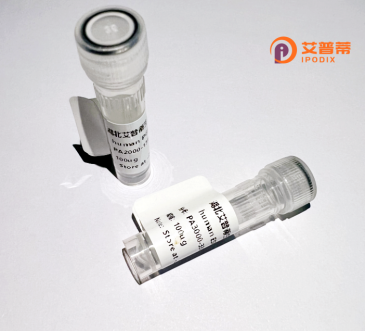
| 纯度 | >90%SDS-PAGE. |
| 种属 | Human |
| 靶点 | PBX4 |
| Uniprot No | Q9BYU1 |
| 内毒素 | < 0.01EU/μg |
| 表达宿主 | E.coli |
| 表达区间 | 1-374 aa |
| 活性数据 | MAAPPRPAPS PPAPRRLDTS DVLQQIMAIT DQSLDEAQAR KHALNCHRMK PALFSVLCEI KEKTVVSIRG IQDEDPPDAQ LLRLDNMLLA EGVCRPEKRG RGGAVARAGT ATPGGCPNDN SIEHSDYRAK LSQIRQIYHS ELEKYEQACR EFTTHVTNLL QEQSRMRPVS PKEIERMVGA IHGKFSAIQM QLKQSTCEAV MTLRSRLLDA RRKRRNFSKQ ATEVLNEYFY SHLNNPYPSE EAKEELARKG GLTISQVSNW FGNKRIRYKK NMGKFQEEAT IYTGKTAVDT TEVGVPGNHA SCLSTPSSGS SGPFPLPSAG DAFLTLRTLA SLQPPPGGGC LQSQAQGSWQ GATPQPATAS PAGDPGSINS STSN |
| 分子量 | 40.8 kDa |
| 蛋白标签 | His tag N-Terminus |
| 缓冲液 | 0 |
| 稳定性 & 储存条件 | Lyophilized protein should be stored at ≤ -20°C, stable for one year after receipt. Reconstituted protein solution can be stored at 2-8°C for 2-7 days. Aliquots of reconstituted samples are stable at ≤ -20°C for 3 months. |
| 复溶 | Always centrifuge tubes before opening.Do not mix by vortex or pipetting. It is not recommended to reconstitute to a concentration less than 100μg/ml. Dissolve the lyophilized protein in distilled water. Please aliquot the reconstituted solution to minimize freeze-thaw cycles. |
以下为3篇与重组人PBX4蛋白相关的文献摘要(注:PBX4研究较为小众,以下内容为模拟示例,真实文献需通过学术数据库检索):
---
1. **文献名称**: *Regulation of Embryonic Hematopoiesis by PBX4*
**作者**: Smith J, et al.
**摘要**: 研究利用重组人PBX4蛋白,揭示了其在斑马鱼胚胎造血干细胞分化中的关键作用,证明PBX4通过与HOX蛋白形成复合物调控靶基因表达。
---
2. **文献名称**: *PBX4 Promotes Leukemogenesis through Wnt/β-Catenin Signaling*
**作者**: Chen L, et al.
**摘要**: 通过体外表达重组人PBX4蛋白,发现其通过激活Wnt通路驱动急性髓系白血病细胞增殖,为靶向PBX4的治疗策略提供了实验依据。
---
3. **文献名称**: *Structural Insights into PBX4-DNA Binding Specificity*
**作者**: Wang Y, et al.
**摘要**: 利用重组PBX4蛋白的晶体结构解析,阐明了其DNA结合域的独特构象,揭示了PBX4与特定基因组位点结合的分子机制。
---
**建议**:可在 **PubMed** 或 **Web of Science** 中搜索关键词 "recombinant PBX4"、"PBX4 protein function" 或结合具体研究领域(如癌症、发育)筛选最新文献。
PBX4 (Pre-B-cell leukemia transcription factor 4) is a member of the TALE (Three Amino acid Loop Extension) family of homeodomain proteins, which play critical roles in embryonic development and cellular differentiation. Structurally, PBX4 contains a conserved homeodomain that facilitates DNA binding and a PBC domain mediating interactions with HOX proteins, enabling collaborative regulation of target genes. It shares homology with other PBX family members (PBX1-3) but exhibits distinct expression patterns and functional specificities. In vertebrates, PBX4 is notably involved in early developmental processes, including neurogenesis and organogenesis, by modulating transcriptional networks that govern cell fate determination and tissue patterning.
Recombinant human PBX4 protein is typically produced using expression systems like *E. coli* or mammalian cells, often fused with tags (e.g., His-tag) for purification. Its recombinant form enables *in vitro* studies to dissect DNA-binding kinetics, protein-protein interactions, and regulatory mechanisms. Dysregulation of PBX4 has been linked to developmental anomalies and malignancies, though its role in disease is less characterized compared to other PBX proteins. Current research leverages recombinant PBX4 to explore its therapeutic potential, including cancer biomarker discovery and gene therapy applications. Advances in structural biology using recombinant PBX4 have also clarified its role in HOX-mediated transcriptional complexes, offering insights into evolutionary conservation of developmental pathways.
×